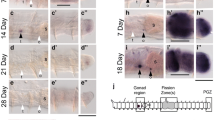Abstract
Recent reports have demonstrated a cost associated with intersexuality in Amphipoda, including reduced fecundity and fertility. In this study, the gross morphology of the gonads in normal and intersex Echinogammarus marinus (Amphipoda) were compared to determine whether resource allocation to gonadal tissue accounted for this reduced fitness. Evidence for the presence of the male sex-determining hormone, androgenic gland hormone (AGH), was compared between sexual phenotypes using MALDI mass spectrometry. Two distinct intersex phenotypes (‘male’ intersex and ‘female’ intersex) were found, with variation in gonadal structure corresponding with external phenotype. Examination of male intersexes revealed normal testicular development (testes, seminal vesicles and vas deferens), but also revealed the formation of an oviduct. Ovaries of intersex females showed normal ovarian development, but were reduced in length by approximately 20% due to the presence of vas deferens. The number of vas deferens in intersex females was equal to the number (one or two) of genital papillae. We hypothesise that the reduced ovarian length observed in intersex females is a likely cause of the reduced brood size previously reported in intersex females of this species. Variation in the sexual phenotype corresponded both to development of the androgenic gland and to expression of a peptide fragment corresponding to the A chain of androgenic gland hormone (AGH). Androgenic glands and a putative AGH peptide were present in males. However, in both normal and intersex females, the androgenic glands were only present in a rudiment form and the peptide was not detected. Intersex males were found to possess abnormal glands that appeared hypertrophied. However, AGH peptides were not detected, supporting the suggestion that the intersex phenotype is manifested via perturbations of AGH.






Similar content being viewed by others
References
Bulnheim H-P(1965) Untersuchungen über intersexualität bei Gammarus duebeni (Crustacea, Amphipoda). Helgoländer wiss. Meersunters 12:349–394
Charniaux-Cotton H (1954) Decouverte chez un crustace (Orchestia gammarella) d’une glande endocrine responsible de la differenciation des caracteres sexuels primaries et secondaires males. C R Acad Sci Paris 239:780–782
Charniaux-Cotton H, Payen G (1985) Sexual differentiation. In: Bliss DE, Mantel LH (eds) The biology of crustacea. Academic Press, London
Charnov E L (1982). The theory of sex allocation. Princeton University Press, N.J.
Dunn AM, Adams J, Smith JE (1990) Intersexes in a shrimp: a possible disadvantage of environmental sex determination. Evolution 44:1875–1878
Dunn AM, Adams J, Smith JE (1993) Is intersexuality a cost of environmental sex determination in Gammarus duebeni? J Zool 231:383–389
Dunn AM, Adams J, Smith JE (1994) Intersexuality in the crustacean Gammarus deubeni. Invert Reprod Dev 25:139–142
Ford AT, Fernandes TF, Rider SA, Read PA, Robinson CD, Davies IM (2003) Reproduction in the amphipod, Echinogammarus marinus: a comparison between normal and intersex specimens. J Mar Biol Assoc UK 83:937–940
Ford AT, Fernandes TF, Read PA, Robinson CD, Davies IM (2004a) The costs of intersexuality: a crustacean perspective. Mar Biol 145:951–957
Ford AT, Fernandes TF, Rider SA, Read PA, Robinson CD, Davies IM (2004b) Endocrine disruption in a marine amphipod? Field observations of intersexuality and de-masculinisation. Mar Environ Res 58:169–173
Fowler RJ, Leonard BV (1999) The structure and function of the androgenic gland in Cherax destructor (Decapoda: Parastacidae). Aquaculture 171:1487–1489
Ginsburger-Vogel T (1975) Temperature-sensitive intersexuality and its determinism in Orchestia gammarella Pallas. In: Reinboth E (ed) Intersexuality in the animal kingdom. Springer, Berlin Heidelberg New Yorkj, pp 106–120
Ginsburger-Vogel T (1991) Intersexuality in Orchestia-Mediterranea Costa, 1853, and Orchestia-Aestuarensis Wildish, 1987 (Amphipoda) - a consequence of hybridization or parasitic infestation. J Crust Biol 11:530–539
Hastings MH (1981) Intersex specimens of the amphipod, Ampelisca brevicornis (Costa). Crustaceana 41:199–205
Hough AR, Bannister NJ, Naylor E (1992) Intersexuality in the Mysid Neomysis integer. J Zool 226:585–588
Jobling S, Coey S, Whitmore JG, Kime DE, Van Look KJW, McAllister BG, Beresford N, Henshaw AC, Brighty G, Tyler CR (2002) Wild intersex roach (Rutilus rutilus) have reduced fertility. Biol Reprod 67:515–524
Kelly A, Hatcher M, Dunn A (2003) Intersexuality in the amphipod Gammarus duebeni results from incomplete feminisation by the vertically transmitted parasitic sex ratio distorter Nosema granulosis. Evol Ecol 18:121–132
Ladewig V, Jungmann D, Koehler A, Schirling M, Triebskorn R, Nagel R (2002) Intersexuality in Gammarus fossarum Koch, 1835 (Amphipoda). Crustaceana 75:1289–1299
Martin G, Sorokine O, Moniatte M, Bulet P, Hetru C, Van Dorsselaer A (1999) The structure of a glycosylated protein hormone responsible for sex determination in isopod, Armadillidium vulgare. Eur J Biochem 262:727–736
Okuno A, Hasegawa Y, Ohira T, Katakura Y, Nagasawa H (1999) Characterisation and cDNA cloning of androgenic gland hormone of the terrestrial isopod Armadillidium vulgare. Biochem Biophys Res Comm 264:419–423
Rodgers-Gray TP, Smith JE, Ashcroft AE, Isaac RE, Dunn AM (2004) Mechanisms of parasite-induced sex reversal in Gammarus duebeni. Int J Parasitol 34:747–753
Rudolph E, Verdi A, Tapia J (2001) Intersexuality in the burrowing crayfish, Parastacus varicosus Faxon, 1898 (Decapoda, Parastacidae). Crustaceana 74:27–37
Sexton EW (1924) The moulting and growth-stages of Gammarus, with descriptions of the normals and intersexes of G. cheureuxi. J Mar Biol Assoc UK 13:340–401
Sexton EW, Huxley JS (1921) Intersexes in Gammarus cheureuxi and related forms. J Mar Biol Assoc UK 12:506–556
Takahashi T, Araki A, Nomura Y, Koga M, Arizono K (2000) The occurrence of dual-gender imposex in Japanese freshwater crab. J Health Sci 46:376–379
Taketoni Y, Nishikawa K (1996) Sex reversal by implantation of enthanol-treated androgenic glands of female isopods, Armadillidium vulgare (Malacostraca, Crustacea). Gen Comp Endocrinol 111:367–375
Acknowledgements
We would like to thank Professor Elwyn Isaac and Dr Alison Ashcroft for advice and assistance with the mass spectrometry; and Mr Adrian Hick for his help with the electron microscopy.
Author information
Authors and Affiliations
Corresponding author
Additional information
An erratum to this article can be found at http://dx.doi.org/10.1007/s00227-005-1636-3
Communicated by J.P. Thorpe, Port Erin
Rights and permissions
About this article
Cite this article
Ford, A.T., Rodgers-Gray, T.P., Davies, I.M. et al. Abnormal gonadal morphology in intersex, Echinogammarus marinus (Amphipoda): a possible cause of reduced fecundity?. Marine Biology 147, 913–918 (2005). https://doi.org/10.1007/s00227-005-1601-1
Received:
Accepted:
Published:
Issue Date:
DOI: https://doi.org/10.1007/s00227-005-1601-1




